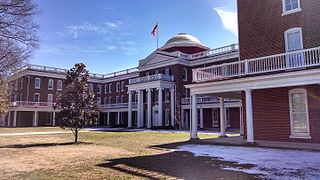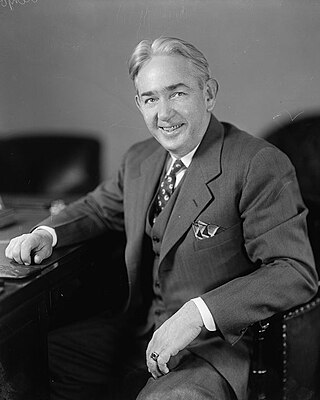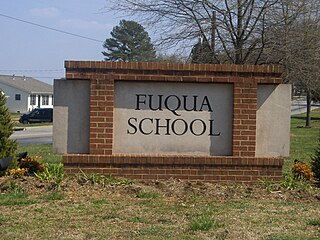
Prince Edward County is located in the Commonwealth of Virginia. As of the 2020 census, the population was 21,849. Its county seat is Farmville.

James Lindsay Almond Jr. was an American lawyer, state and federal judge and Democratic party politician. His political offices included as a member of the U.S. House of Representatives from Virginia's 6th congressional district (1946-1948), 26th Attorney General of Virginia (1948-1957) and the 58th Governor of Virginia (1958-1962). As a member of the Byrd Organization, Almond initially supported Massive resistance to the integration of public schools following the United States Supreme Court decisions in Brown v. Board of Education- however, when Virginia and federal courts ruled segregation unconstitutional, Almond worked with the legislature to end massive resistance. Almond then became an associate judge of the United States Court of Customs and Patent Appeals (1962-1973), and after retiring, continued to serve as Senior Judge of the United States Court of Customs and Patent Appeals (1973-1982) and then Senior Judge of the United States Court of Appeals for the Federal Circuit from 1982, until his death in 1986.
Massive resistance was a strategy declared by U.S. Senator Harry F. Byrd Sr. of Virginia and his son Harry Jr.'s brother-in-law, James M. Thomson, who represented Alexandria in the Virginia General Assembly, to get the state's white politicians to pass laws and policies to prevent public school desegregation, particularly after Brown v. Board of Education.

Albertis Sydney Harrison Jr. was an American politician and jurist. A member of the Democratic Party associated with Virginia's Byrd Organization, he was the 59th Governor of Virginia in 1962–66, and the first governor of Virginia to have been born in the 20th century.

Segregation academies are private schools in the Southern United States that were founded in the mid-20th century by white parents to avoid having their children attend desegregated public schools. They were founded between 1954, when the U.S. Supreme Court ruled that segregated public schools were unconstitutional, and 1976, when the court ruled similarly about private schools.

Fuqua School is a private primary and secondary school located in Farmville, Virginia. It was founded as Prince Edward Academy in 1959 as a segregation academy and renamed after businessman J. B. Fuqua made a large contribution to the school in 1993.

The Mississippi Delta region has had the most segregated schools -- and for the longest time—of any part of the United States. As recently as the 2016–2017 school year, East Side High School in Cleveland, Mississippi, was practically all black: 359 of 360 students were African-American.

Mosby Garland Perrow Jr. was a Virginia lawyer and state senator representing Lynchburg, Virginia. A champion of Virginia's public schools, Perrow became a key figure in Virginia's abandonment of "Massive Resistance" to public school desegregation, including by chairing a joint legislative committee colloquially known as the Perrow Commission.
The Stanley Plan was a package of 13 statutes adopted in September 1956 by the U.S. state of Virginia. The statutes were designed to ensure racial segregation would continue in that state's public schools despite the unanimous ruling of the U.S. Supreme Court in Brown v. Board of Education (1954) that school segregation was unconstitutional. The legislative program was named for Governor Thomas B. Stanley, a Democrat, who proposed the program and successfully pushed for its enactment. The Stanley plan was a critical element in the policy of "massive resistance" to the Brown ruling advocated by U.S. Senator Harry F. Byrd Sr. The plan also included measures designed to curb the Virginia state chapter of the National Association for the Advancement of Colored People (NAACP), which many Virginia segregationists believed was responsible for "stirring up" litigation to integrate the public schools.
James McIlhany Thomson was a member of the Virginia House of Delegates representing Alexandria from 1956 to 1977. A member of the Byrd Organization, Thomson became the Virginia House Democratic floor leader, a position which he held until 1977.
Armistead Lloyd Boothe was a Virginia Democratic legislator representing Alexandria, Virginia: first as a delegate in the Virginia General Assembly and later as a State Senator from the newly created 36th District. A lifelong Democrat, Boothe helped lead his party's progressive faction, particularly as they opposed the Byrd Organization's policy of Massive Resistance to racial integration in Virginia's public schools.

In the United States, school integration is the process of ending race-based segregation within American public and private schools. Racial segregation in schools existed throughout most of American history and remains an issue in contemporary education. During the Civil Rights Movement school integration became a priority, but since then de facto segregation has again become prevalent.
The Commission on Public Education, known as the VPEC or Gray Commission, was a 32-member commission established by Governor of Virginia Thomas B. Stanley on August 23, 1954 to study the effects of the U.S. Supreme Court decisions in Brown v. Board of Education issued on May 17, 1954 and May 31, 1955, and to make recommendations. Its counsel were David J. Mays and his associate Henry T. Wickham.
Robert Young Button served two terms as Attorney General of Virginia, as well as a fifteen years as Virginia State Senator. Button rose through the ranks of the Byrd Organization and became one of its leading members as it ultimately crumbled as a result of the Massive Resistance crisis.
Earl Abbath Fitzpatrick was a Virginia lawyer and member of the Virginia General Assembly representing Roanoke between 1940 and 1959, first as a delegate and then as a state Senator. A lieutenant in the Byrd Organization, Fitzpatrick was active in the Massive Resistance to racial integration vowed by U.S. Senator Harry F. Byrd after the U.S. Supreme Court decisions in Brown v. Board of Education. He introduced much of the segregationist legislation and was vice-chairman of the Boatwright Committee which investigated the NAACP for litigating on behalf of civil rights, before being defeated in the 1959 Democratic primary.
The Commission on Education, known as the Perrow Commission after its chairman, Virginia state senator Mosby Perrow Jr., was a 40-member commission established by Governor of Virginia J. Lindsay Almond on February 5, 1959 after the Virginia Supreme Court in Harrison v. Day and a three-judge federal court in James v. Almond had both struck down significant portions of the Stanley Plan, which had implemented Massive Resistance to the U.S. Supreme Court decisions in Brown v. Board of Education issued on May 17, 1954 and May 31, 1955. Four legislators were appointed from each of the ten U.S. Congressional districts in Virginia. Compared to the Gray Commission that Governor Thomas B. Stanley had appointed five years previously, Perrow Commission included more representatives from cities, northern and Western Virginia, although many members served on both commissions.
John Segar Gravatt was a Virginia lawyer and trial judge. He is often known as J. Segar Gravatt, although this is also the appellation of his youngest daughter, Jacqueline Segar Gravatt, who was the first woman ordained as an Episcopal minister in Virginia.
John S. Mosby Academy was a private high school in Front Royal, Virginia, established in 1959 when the city's schools were ordered to desegregate following the landmark Brown v. Board of Education Supreme Court ruling. It was named for John S. Mosby, a Confederate colonel.
Jamestown Academy was a private school in James City County, Virginia, established in 1964 when the local public schools were ordered to desegregate following the landmark Brown v. Board of Education Supreme Court ruling.
The Mississippi Red Clay region was a center of education segregation. Before the Brown v. Board of Education decision in 1954, Mississippi sponsored freedom of choice policies that effectively segregated schools. After Brown, the effort was private with some help from government. Government support has dwindled in every decade since. In the state capital, Jackson, some public schools were converted to white-only Council schools. Today, some all-white and mostly-white private schools remain throughout the region as a legacy of that period.








